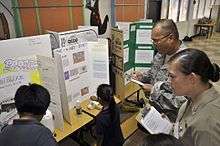Science fair
A science fair is a competitive event, hosted by schools worldwide. The distinguishing characteristic of a science fair is that project entries employ the scientific method to test a hypothesis.[1] Science fairs are not exhibits or mere displays of projects. Students present their science project results in the form of a report, display board, and/or models that they have created. Science fairs allow students in elementary, middle and high schools to compete in science and/or technology activities.[2] The goal of a science fair is for students to answer a question based on a hypothesis. Students often work on science fair projects in addition to their school work. Therefore, most science fair entries are usually modified versions of existing experiments. Display boards help communicate the nuances of a project to science fair judges, visitors, and other entrants.[3]

Science fairs also provide a mechanism for students with intense interest in the sciences to be paired with mentors from nearby colleges and universities, so that they can access to instruction and equipment that the local schools can.
History
Science fairs date back to 1942, when William Emerson Ritter and Edward W. Scripps created "The Science Talent Search" for high school students. The first American National Science Fair was won by Alan J. Fletcher when he was 18, winning with a display on the laws of motion. In the United States, science fairs became popular in the early 1950s. Interest in the sciences was at a new high after the world witnessed the use of the first two atomic weapons and the dawn of television. As the decade progressed, science stories in the news, such as Jonas Salk's vaccine for polio and the launch of Sputnik, brought science fiction to reality and attracted increasing numbers of students to fairs.[4]
Science fair competitions
Most countries have regional science fairs in which interested students can freely participate. Winners of these regional fairs send students to national fairs such as ISEF[5] and CWSF. National science fairs typically send winners to international fairs such as ISEF (which is a national and an international science fair) and EUCYS.
See also
- Google Science Fair
- Intel International Science and Engineering Fair
- Interest Fair
References
- "Designing a Science Fair Project". learning-center.homesciencetools.com. Retrieved 2019-08-23.
- Fredericks, Anthony D. (2000). "What is a science fair project?". Science Fair Handbook. Retrieved 8 March 2018.
- see Heather Won Tesoriero, The Class: A HECK-Changing Teacher, His World-Changing Kids, and the Most Inventive Classroom in America (2018) for how the top projects are built.
- Cox, Jimmy. "A History of Science Fairs". Streetdirectory. Retrieved 8 March 2018.
- "Student Science - Find a Fair". findafair.societyforscience.org. Retrieved 2018-11-14.
Further reading
- Haysom, John (2013). Science fair warm-up : learning the practice of scientists. Arlington, Va.: NSTA. ISBN 9781936959235.
- Schank, Hana (12 March 2015). "Science Fairs Aren't So Fair". The Atlantic. Retrieved 8 March 2018.
- Won Tesoriero, Heather. The Class: A Life-Changing Teacher, His World-Changing Kids, and the Most Inventive Classroom in America (2018) in-depth narrative of science fair students at top high school in 2016-17. excerpt; also online review